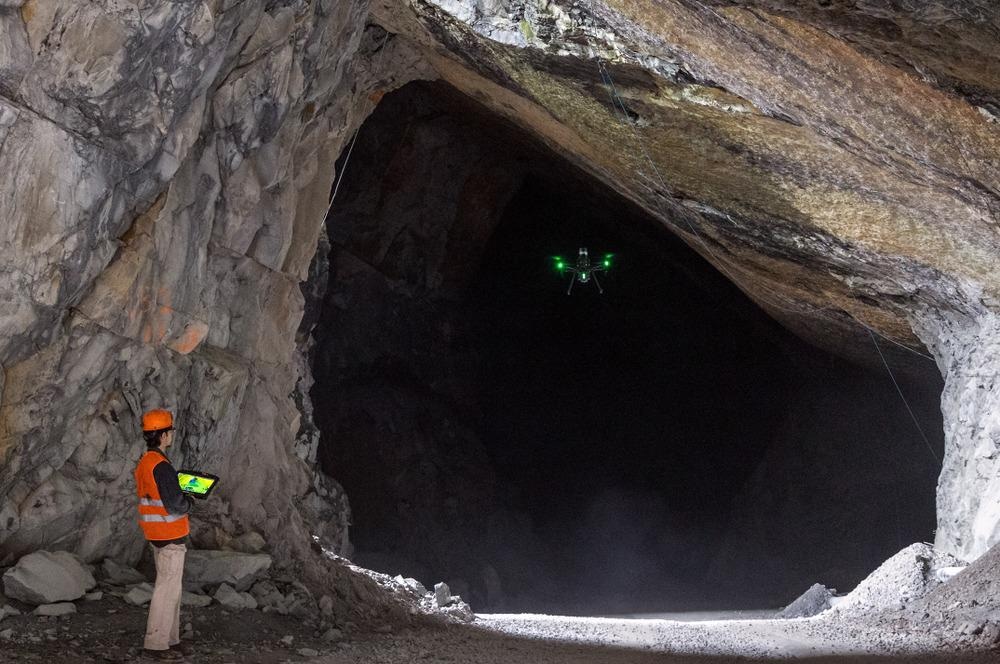The use of drones is increasing dramatically. In the US alone, the FFA reported almost 900,000 registered drones in 2021. The number of drones in use in the US is predicted to be around ten times that of commercial aircraft. Multiple industries are benefiting from the boom in the drone industry, which has been facilitated by increasing improvements in drone technology over recent years. Here, we discuss the various areas in which drones are positively impacting the mining industry.

Image Credit: mineronbaystreet/Shutterstock.com
Safety and Surveillance in Hazardous Areas
Mining operations often take place in areas of hazardous terrain. Drones are being used to aid in these dangerous areas to prevent human workers from being placed in harm. Underground mining, in particular, poses great risks to workers. Materials to be excavated may lie in areas that are challenging to reach.
Cameras on board drones can feed back images that can be analyzed safely from remote areas. Drones can also be fitted with various cameras that can provide more in-depth data than standard cameras, such as infrared or thermal cameras.
Drones can facilitate remote excavation techniques, where robots are used to extract materials in place of humans to prevent them from being exposed to dangerous terrains and conditions (such as poor air quality beneath the ground’s surface.
Asset Management in Mining
Drones are incredibly useful tools for asset management in mining. Previously, asset management processes were very time-consuming, vulnerable to inaccuracy, costly (due to the time required), and risky for human workers to carry out. Drones provide an effective, accurate, and time-effect alternative to asset management on mining sites.
With the ability to capture images to the resolution of a millimeter and inspect objects from all angles, drones are a valuable asset management tool capable of inspecting vast and intricate landscapes in just a few hours. Upon inspection completion, the images captured by the drone are used to generate a 3D model of the asset, which can then be rendered and analyzed for the specific requirements of the mining company.
Asset management via drones drastically reduces site downtime. Drones can be deployed immediately to survey any region of the mining site, whereas a manual inspection may take days and require further infrastructures, such as scaffolding or specialized vehicles. Downtime can have a huge negative impact on the productivity of operations, therefore, drones greatly benefit mining companies by preventing this.
Time-Lapse Photography
Time-lapse photography is the collection of many photos of the same site at intervals of seconds, minutes, hours, days, or longer. These images can then be compiled into a video so that the site can be viewed over a certain period of time.
Time-lapse photography is important to mining as it can help visualize changes to the site over time. These changes may indicate areas that need attention, such as changes to terrain that may not be safe. Drones can be deployed to safely and accurately collect photographs at predetermined intervals.
Measuring Stockpile Inventory
Stockpile inventory management is one of the most common uses of drones for the mining industry and is rapidly becoming the go-to tool for surveying earthwork sites globally. Drones can produce 3D maps from images taken during flights around mining sites, allowing for complex stockpile volume calculations.
The adoption of drones to calculate stockpile measurements in the mining industry has made the process far easier and more streamlined than it was previously.
Drones can be used to produce geo-referenced images of the mining site that can be used in combination with photogrammetry to create a 3D map of the worksite. Measurements taken from drones in this context have been proven to be accurate to around 3 cm, making the system reliable and accurate.
Infrastructure Upkeep and Inspection
Similar to how they can assist with stockpile inventory, drones can easily gather information on infrastructure so that it can be analyzed with the purpose of highlighting maintenance issues.
Images collected via drones can be highly detailed and can display areas of the mining site that are inaccessible or difficult to see from the ground via the naked eye. Therefore, drones offer the opportunity to spot potential issues before they occur, allowing for pre-emptive maintenance procedures.
Site Mapping
The mining industry is also using drones for site mapping to conduct aerial surveys with specialist cameras, such as RGB (for photogrammetry), multispectral, thermal, or LiDAR sensors. Sites can be mapped rapidly, accurately, and reliably using drones.
A Safer Mining Industry
Drones are already being widely used to benefit the mining industry.
In the coming years, it is expected that drone technology will improve further and these advancements will likely be leveraged by the mining industry. We can expect this to result in a safer industry, where human workers can be spared dangerous tasks and hazards can be better predicted and avoided.
References and Further Reading
Giacomo, Lee. (2021). From Europe to Asia, mining drones are taking over more than just mapping. [Online] Verdict. Available at: https://www.verdict.co.uk/from-europe-to-asia-mining-drones-are-taking-over-more-than-just-mapping/ (Accessed April 2022)
Ren, H., Zhao, Y., Xiao, W. and Hu, Z. (2019) A review of UAV monitoring in mining areas: current status and future perspectives. International Journal of Coal Science & Technology, 6(3), pp.320-333. https://link.springer.com/article/10.1007/s40789-019-00264-5
Shahmoradi, J., Talebi, E., Roghanchi, P. and Hassanalian, M. (2020) A Comprehensive Review of Applications of Drone Technology in the Mining Industry. Drones, 4(3), p.34. https://www.mdpi.com/2504-446X/4/3/34
Disclaimer: The views expressed here are those of the author expressed in their private capacity and do not necessarily represent the views of AZoM.com Limited T/A AZoNetwork the owner and operator of this website. This disclaimer forms part of the Terms and conditions of use of this website.